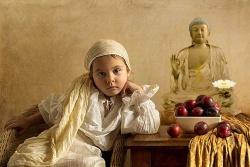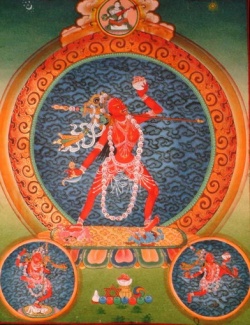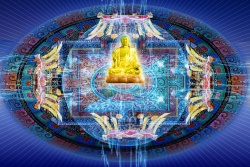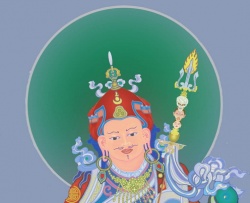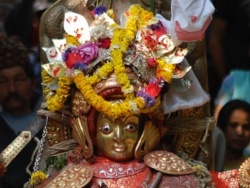Difference between revisions of "Sermey Jetsun Khen Rinpoche Losang Tharchin"
(Created page with " Khen Rinpoche Geshe Lobsang Tharchin was born in Lhasa, Tibet in 1921 and entered Sera Monastery there at an early age. He proceeded through the...") |
|||
| Line 1: | Line 1: | ||
| + | <nomobile>{{DisplayImages|4411|1158|4389|1392|2722}}</nomobile> | ||
| − | + | [[Khen Rinpoche Geshe Lobsang Tharchin]] was born in [[Lhasa]], [[Tibet]] in 1921 and entered [[Sera Monastery]] there at an early age. | |
| − | [[Khen Rinpoche | ||
He proceeded through the rigorous 25 year program of [[monastic]] studies under the guidance of [[Pabongka Rinpoche]] and [[Kyabje Trijang Rinpoche]]. Upon successful completion of public {{Wiki|examination}} by the best [[scholars]] of the day, | He proceeded through the rigorous 25 year program of [[monastic]] studies under the guidance of [[Pabongka Rinpoche]] and [[Kyabje Trijang Rinpoche]]. Upon successful completion of public {{Wiki|examination}} by the best [[scholars]] of the day, | ||
| Line 12: | Line 12: | ||
He proved to be the best debater of his graduation year in all of [[Tibet]], making him the “First among the First.” | He proved to be the best debater of his graduation year in all of [[Tibet]], making him the “First among the First.” | ||
| − | [[Khen Rinpoche]] then entered Gyu Mey | + | [[Khen Rinpoche]] then entered [[Gyu Mey Tantric College]], where he completed its course of advanced [[tantric]] studies and [[attained]] a high-ranking administrative position. |
In 1959 [[Rinpoche]] escaped from [[Tibet]] into [[India]] along with [[His Holiness the Dalai Lama]]. | In 1959 [[Rinpoche]] escaped from [[Tibet]] into [[India]] along with [[His Holiness the Dalai Lama]]. | ||
| Line 18: | Line 18: | ||
He became actively involved in resettlement, and compiled a series of textbooks used in the [[Tibetan]] refugee schools. | He became actively involved in resettlement, and compiled a series of textbooks used in the [[Tibetan]] refugee schools. | ||
| − | [[Khen Rinpoche]] came to the [[Wikipedia:United States of America (USA)|United States]] in 1972 and became [[Abbot]] of Rashi Gempil Ling | + | [[Khen Rinpoche]] came to the [[Wikipedia:United States of America (USA)|United States]] in 1972 and became [[Abbot]] of [[Rashi Gempil Ling Temple]] in {{Wiki|New Jersey}}. |
| − | After going to [[South India]] in 1991 and serving as [[Abbot | + | After going to [[South India]] in 1991 and serving as [[Abbot of Sera Mey monastery]] for some time, he returned to the [[Wikipedia:United States of America (USA)|United States]]. |
| − | [[Khen Rinpoche | + | [[Khen Rinpoche Geshe Lobsang Tharchin]] was a [[lifetime]] director and an [[abbot emeritus of Sera Mey monastery]]. |
[[Khen Rinpoche]] passed on from this [[life]] on [[Je Tsongkapa]] Day, Dec. 7, 2004 | [[Khen Rinpoche]] passed on from this [[life]] on [[Je Tsongkapa]] Day, Dec. 7, 2004 | ||
| Line 29: | Line 29: | ||
| − | (From the Forward to The [[Principal Teachings of Buddhism]] by [[Tsongkhapa]], with a commentary by [[Pabongka Rinpoche]], translated by [[Geshe | + | (From the Forward to The [[Principal Teachings of Buddhism]] by [[Tsongkhapa]], with a commentary by [[Pabongka Rinpoche]], translated by [[Geshe Lobsang Tharchin]], [[Mahayana Sutra]] and [[Tantra]] Press, 1998, all {{Wiki|emphasis}} and formatting mine…) |
….the [[Wikipedia:Sage (sophos|sage]] foretold that if the child were placed in [[Gyalrong House]], something wonderful would happen with him in the {{Wiki|future}}. | ….the [[Wikipedia:Sage (sophos|sage]] foretold that if the child were placed in [[Gyalrong House]], something wonderful would happen with him in the {{Wiki|future}}. | ||
| Line 35: | Line 35: | ||
It was at this time that the glorious [[Pabongka Rinpoche]], the author of the commentary you are about to read, came into my [[life]]. | It was at this time that the glorious [[Pabongka Rinpoche]], the author of the commentary you are about to read, came into my [[life]]. | ||
| − | Like me he had as a young man taken his course of studies at the [[Sera Mey College]] of [[Sera Monastery]]; | + | Like me he had as a young man taken his course of studies at the [[Sera Mey College]] of [[Sera Monastery]]; in fact, he was from the same house, [[Gyalrong]]. [[Pabongka Rinpoche]] was born in 1878, at a town called [[Tsawa Li]] in the [[Yeru Shang]] district of the [[state]] of [[Tsang]], [[north]] of [[Lhasa]]. |
| − | |||
| − | in fact, he was from the same house, [[Gyalrong]]. [[Pabongka Rinpoche]] was born in 1878, at a town called [[Tsawa]] | ||
| − | Later on, the youngster was found to be a [[reincarnation | + | Later on, the youngster was found to be a [[reincarnation of the [[Changkya line]], which included the illustrious [[scholar]] [[Changkya Rolpay Dorje]] (1717-1786). |
| − | The [[lamas]] of this line had done much [[teaching]] in the regions of [[Mongolia]] and | + | The [[lamas]] of this line had done much [[teaching]] in the regions of [[Mongolia]] and [[China]]—even in the court of the {{Wiki|Chinese}} [[emperor]] himself—and the [[name]] “[[Changkya]]” had very strong {{Wiki|Chinese}} connotations. |
Already in those days the [[Tibetan government]] and [[people]] were [[sensitive]] to the pressures put on us by our powerful neighbor to the [[east]], so the [[name]] “[[Changkya]]” was ruled out, and the boy declared to be “[[Pabongka]]” instead. | Already in those days the [[Tibetan government]] and [[people]] were [[sensitive]] to the pressures put on us by our powerful neighbor to the [[east]], so the [[name]] “[[Changkya]]” was ruled out, and the boy declared to be “[[Pabongka]]” instead. | ||
| Line 47: | Line 45: | ||
[[Pabongka]], also known as Parongka, is a large and famous rock-formation about three {{Wiki|miles}}’ walk from our [[Sera Monastery]]. | [[Pabongka]], also known as Parongka, is a large and famous rock-formation about three {{Wiki|miles}}’ walk from our [[Sera Monastery]]. | ||
| − | The very [[word]] | + | The very [[word]] “[[pabong]]” means in our [[language]] a large boulder, or {{Wiki|mass}} of rock. |
His [[family]] were of the [[nobility]] and owned a modest estate called Chappel Gershi. | His [[family]] were of the [[nobility]] and owned a modest estate called Chappel Gershi. | ||
| Line 56: | Line 54: | ||
He was not, but the [[Wikipedia:Sage (sophos|sage]] foretold that if the child were placed in the [[Gyalrong House]] of [[Sera Mey College]], something wonderful would happen with him in the {{Wiki|future}}. | He was not, but the [[Wikipedia:Sage (sophos|sage]] foretold that if the child were placed in the [[Gyalrong House]] of [[Sera Mey College]], something wonderful would happen with him in the {{Wiki|future}}. | ||
| + | {{R}} | ||
| + | https://truthaboutshugden.wordpress.com/2009/03/09/sermey-jetsun-khen-rinpoche-losang-tharchin/ | ||
| + | [[Category:Gelug Teachers]] | ||
| + | [[Category:Gelugpa Masters]] | ||
| + | {{TibetanTerminology}} | ||
Revision as of 16:06, 5 April 2016
Khen Rinpoche Geshe Lobsang Tharchin was born in Lhasa, Tibet in 1921 and entered Sera Monastery there at an early age.
He proceeded through the rigorous 25 year program of monastic studies under the guidance of Pabongka Rinpoche and Kyabje Trijang Rinpoche. Upon successful completion of public examination by the best scholars of the day,
Rinpoche was awarded the highest degree of Hlarampa Geshe (Doctor of Theology) with honors, and is one of the last living Hlarampa Geshes educated in Tibet.
He proved to be the best debater of his graduation year in all of Tibet, making him the “First among the First.”
Khen Rinpoche then entered Gyu Mey Tantric College, where he completed its course of advanced tantric studies and attained a high-ranking administrative position.
In 1959 Rinpoche escaped from Tibet into India along with His Holiness the Dalai Lama.
He became actively involved in resettlement, and compiled a series of textbooks used in the Tibetan refugee schools.
Khen Rinpoche came to the United States in 1972 and became Abbot of Rashi Gempil Ling Temple in New Jersey.
After going to South India in 1991 and serving as Abbot of Sera Mey monastery for some time, he returned to the United States.
Khen Rinpoche Geshe Lobsang Tharchin was a lifetime director and an abbot emeritus of Sera Mey monastery.
Khen Rinpoche passed on from this life on Je Tsongkapa Day, Dec. 7, 2004
Like Ribur Rinpoche, Khen Rinpoche was an actual disciple of Je Pabongka, so his words are very precious, giving us a direct impression of this extraordinary master….
(From the Forward to The Principal Teachings of Buddhism by Tsongkhapa, with a commentary by Pabongka Rinpoche, translated by Geshe Lobsang Tharchin, Mahayana Sutra and Tantra Press, 1998, all emphasis and formatting mine…)
….the sage foretold that if the child were placed in Gyalrong House, something wonderful would happen with him in the future.
It was at this time that the glorious Pabongka Rinpoche, the author of the commentary you are about to read, came into my life.
Like me he had as a young man taken his course of studies at the Sera Mey College of Sera Monastery; in fact, he was from the same house, Gyalrong. Pabongka Rinpoche was born in 1878, at a town called Tsawa Li in the Yeru Shang district of the state of Tsang, north of Lhasa.
Later on, the youngster was found to be a [[reincarnation of the Changkya line, which included the illustrious scholar Changkya Rolpay Dorje (1717-1786).
The lamas of this line had done much teaching in the regions of Mongolia and China—even in the court of the Chinese emperor himself—and the name “Changkya” had very strong Chinese connotations.
Already in those days the Tibetan government and people were sensitive to the pressures put on us by our powerful neighbor to the east, so the name “Changkya” was ruled out, and the boy declared to be “Pabongka” instead.
Pabongka, also known as Parongka, is a large and famous rock-formation about three miles’ walk from our Sera Monastery.
The very word “pabong” means in our language a large boulder, or mass of rock.
His family were of the nobility and owned a modest estate called Chappel Gershi.
As a child he exhibited unusual qualities and in his seventh year was taken before Sharpa Chuje Lobsang Dargye, one of the leading religious figures of the day.
The lama felt sure that the boy must be a reincarnated saint, and even went so far as to examine him to see if he were the rebirth of his own late teacher.
He was not, but the sage foretold that if the child were placed in the Gyalrong House of Sera Mey College, something wonderful would happen with him in the future.
Source
https://truthaboutshugden.wordpress.com/2009/03/09/sermey-jetsun-khen-rinpoche-losang-tharchin/
